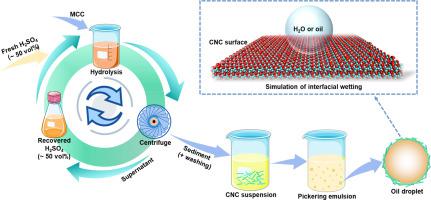International Journal of Biological Macromolecules ( IF 7.7 ) Pub Date : 2021-06-17 , DOI: 10.1016/j.ijbiomac.2021.06.094 Tao Ma 1 , Xinna Hu 1 , Shuyu Lu 1 , Ranran Cui 1 , Jing Zhao 1 , Xiaosong Hu 1 , Yi Song 1

|
Cellulose nanocrystals (CNCs) were successfully produced with good nanoscales and dispersibility, using a recycled sulfuric acid (H2SO4) hydrolysis process. This method, at the cost of an overall 25% increase in the hydrolysis time, could significantly reduce the dosage of H2SO4 by approximately 40% without affecting the per-batch yield and performance of CNCs. The obtained CNCs with an average diameter of 6.0–6.5 nm and an average length of 126–134 nm, were successfully applied in the preparation of oil-in-water (O/W) Pickering emulsions via high-pressure homogenization. The emulsions exhibited good storage stability when the concentration of CNC was 1.0 wt%. Further, understanding the wetting behaviors of surface modified CNCs with solvent is critical for the functional designing of Pickering emulsion. Hence, we gained insights into the wetting of hydrophobic and hydrophilic surfaces of sulfate modified CNCs with water and organic solvent (hexadecane) droplets, using molecular dynamic simulation. The results showed that both surfaces had hydrophilic as well as lipophilic properties. Although the sulfate-grafted surface was more hydrophilic than unmodified CNC, substantial local wetting heterogeneities appeared for both solvents. It provides a deeper understanding of the interfacial interactions between modified CNCs and solvent molecules at the molecular level.
中文翻译:

以可回收硫酸为水解介质制备的纤维素纳米晶及其润湿分子动力学模拟
纤维素纳米晶体 (CNC) 使用回收的硫酸 (H 2 SO 4 ) 水解过程成功地生产出具有良好的纳米级和分散性。这种方法以水解时间整体增加 25% 为代价,可以显着减少 H 2 SO 4的用量大约 40%,而不会影响 CNC 的每批次产量和性能。获得的平均直径为 6.0-6.5 nm,平均长度为 126-134 nm 的 CNCs 成功应用于通过高压均质化制备水包油 (O/W) Pickering 乳液。当CNC的浓度为1.0 wt%时,乳液表现出良好的储存稳定性。此外,了解表面改性 CNC 与溶剂的润湿行为对于 Pickering 乳液的功能设计至关重要。因此,我们使用分子动力学模拟深入了解了硫酸盐改性 CNCs 的疏水和亲水表面与水和有机溶剂(十六烷)液滴的润湿。结果表明,两个表面都具有亲水性和亲油性。尽管硫酸盐接枝的表面比未改性的 CNC 更亲水,但两种溶剂都出现了大量的局部润湿异质性。它在分子水平上提供了对改性 CNC 与溶剂分子之间界面相互作用的更深入理解。











































 京公网安备 11010802027423号
京公网安备 11010802027423号